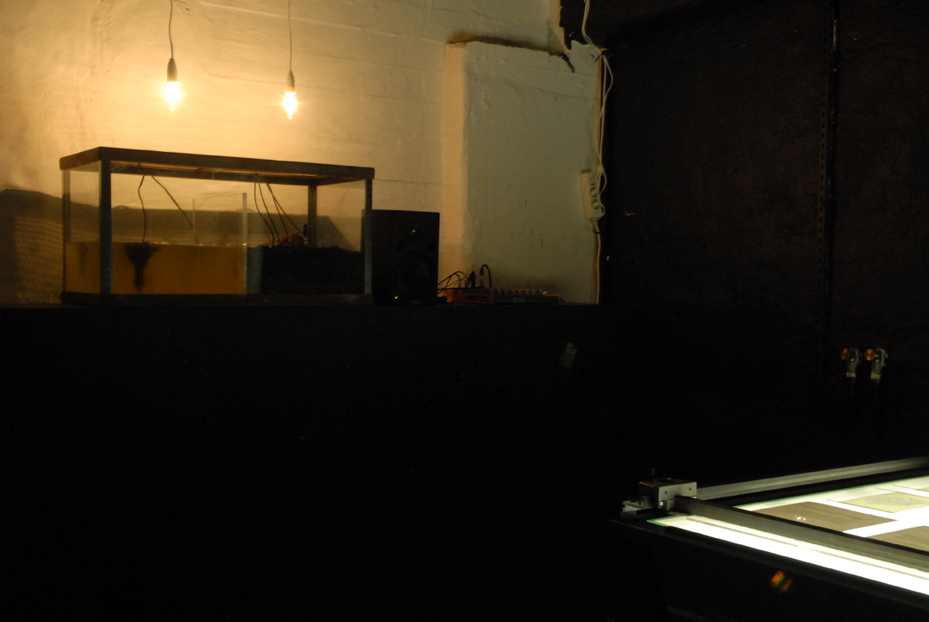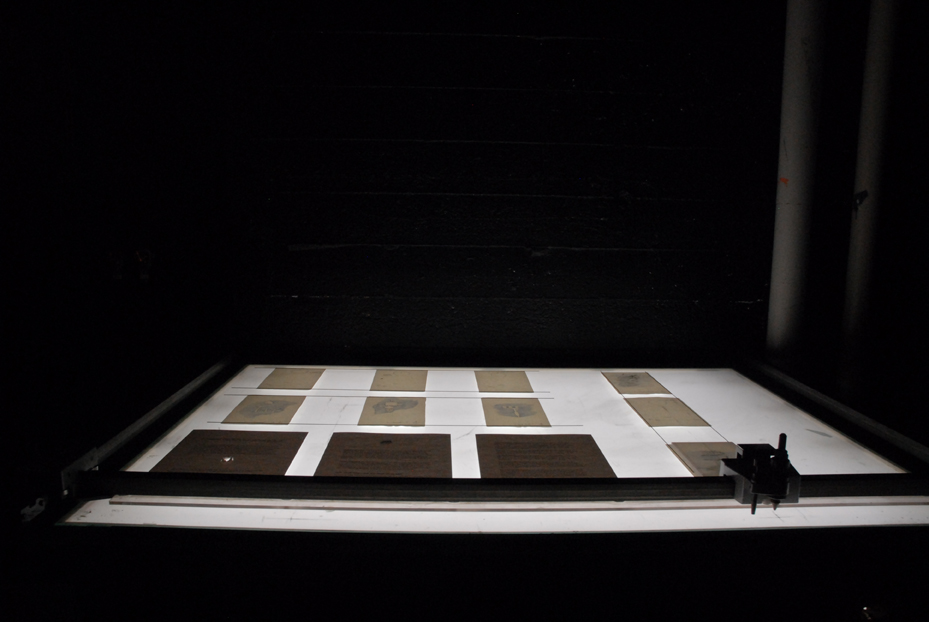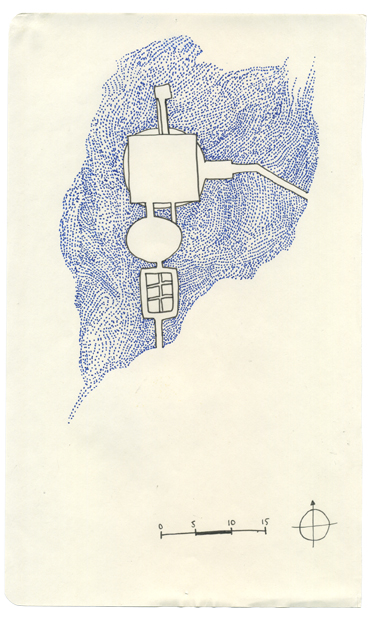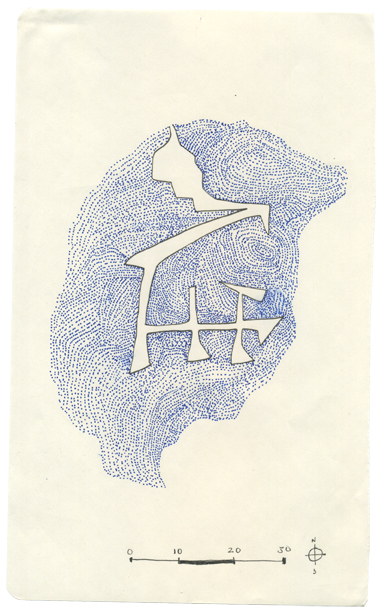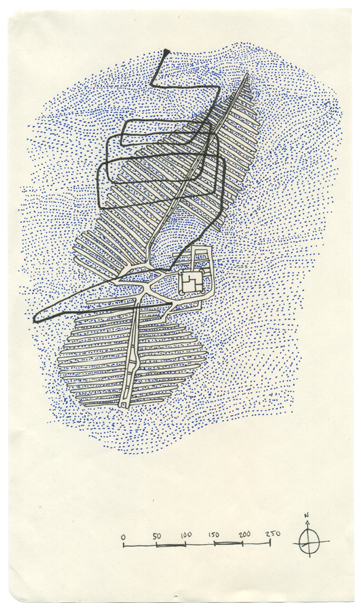holes of… consist of text, drawings, a melting wax sculpture and an aquarium filled with space-gel, ants, hydrophones, contact mics and models of the 4 holes on earth that has been under my investigation; The Global Seed Vault, Damanhur Temples of Humankinds, The Archive of Invisible and Lost Knowledge and Onkalo Nuclear Waste Repository. The installation was made for The Invisible Seminar, organized by Brandon LaBelle at KHIB, Bergen January 2012.
…
…
There is no such thing as a hole by itself Tucholsky
How can we perceive something which is characterized by not being something else –a rupture, a nothingness, something that appears where something else cease? How to perceive a hole? If I cut a hole in this paper, I would create a paperless place that you could see through. An immaterial spot, made of nothing, surrounded by matter. Despite its immateriality, we perceive it as easy as the surrounding paper. Even though a hole in itself is something that does not exist of anything, it has more in common with a material object than for example an abstract conception and is to be located in the spatio-temporal world: it has its own size, shape and position it space even though all these factors are easily changeable.
The criteria for identifying something that seem to be made of nothing can be difficult to specify, but here is Roberto Casati and Achille Varzi´s list of signifiers:
Holes are localized at, but not identical with, regions of space.
Holes are ontologically parasitic: they are always in something else and cannot exist in isolation.
Holes are fillable.
Holes are mereologically structured.
Holes are topologically assorted.
Holes and caveshave functioned as time-capsules throughout history. The oldest artworks were found in holes, as well as the oldest records of ritualistic and performing activity. The choice of caves for such activity is closely connected to the body, both by being shelters and by virtue of their acoustics. Many of the drawings of horses, bison, and mammoths inside caves in Europe seem to match locations that focus, amplify, and transform the sounds of human voices and musical instruments. Historians claim that these sites would therefore have served as places of natural power, supporting the theory that decorated caves were backdrops for religious and magical rituals.
Holes and time are curious roommates. When a hole is a place in a surface allowing passage into or through a thing, or is an open space in a barrier, it invites to focus movements in time to a fixed point: a hole in the Berlin wall or a hole in a pipe (can change the flow and flux of air and change a pitch in the sound of a flute). When a hole is a sunken area forming a separate space in nature or an opening to a void in a rock or a mountain, it has the potential of storing for an undefined future. The duration of the first type of hole is truly different from the latter.
Holy, whole holes…
Collecting is the redemption of things which is to complement the redemption of man
Hannah Arendt
I have had a closer look at some manmade holes that appear in nature: The Global Seed Vault, in Svalbard, Onkalo Nuclear Waste Repository in Finland, Damanhur Temples Of Humankind in Italy, The Archive of Invisibility and Lost Knowledge in China, their practical and symbolic significance, their shapes, architecture and acoustics, their ritualistic aspects and relation to eternity, as a starting point for an exploration of human beings’ efforts to preserve civilization and defy the inevitability of its demise. These cavities can be seen as time capsules even though their reasons and strategies of preserving varies. The first stores seeds for a potential restart of life on earth, the second hide lethal waste as the third seeks to preserve global spirituality, and the last collect gestures that turns objects into art.
The Global Seed Vaultis located on Svalbard. The facility preserves millions of different plant seeds for food crops. The seeds are duplicate samples of seeds held in gene banks worldwide to provide insurance against the loss of seeds in the other gene banks in the case of large-scale regional or global crises and catastrophes.
The Onkalo Nuclear Waste Repository is situated on an island in south-east Finland. The bunker is under construction and is dog about 400 m into the ground. The repository will be ready for the nuclear waste storing in 2020 and it is estimated that it will take about 100 years before it is full: Then, the facility will be sealed and hopefully untouched during the 100.000 years it takes for the radiation to cease.
Damanhur Temples of Humankindwas secretively carved out in a mountain in northern Italy from late seventies. The subterranean new age temple is filled murals, sculptures, mosaic and strained glass with motifs and structures inspired from religious and occult societies from all over the world. The Temples seeks to accelerate the process of creating a collective consciousness to change the destiny of humankind and bringing the world toward sustainability and peace.
The Archive of Invisibility and Lost Knowledgeis located close to Yangshou in China. The archive is dog into the mountain from a natural cave and consist of a complex tunnel system. The facility stores and systematize knowledge of the art of making traditional crafts, art and literature, knowledge that in a large-scale got lost as a result of the cultural revolution. The archive does not store the art objects but aims to map the process of producing its aura.
